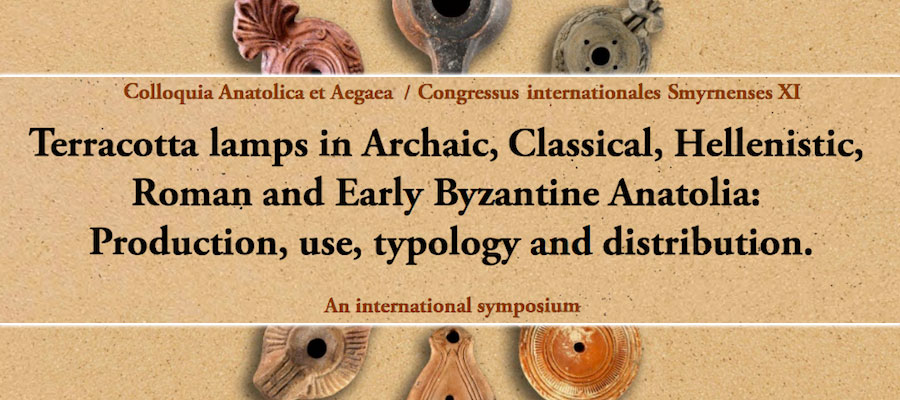Terracotta Lamps in Archaic, Classical, Hellenistic, Roman and Early Byzantine Anatolia: Production, Use, Typology and Distribution: An International Symposium, Dokuz Eylul University (DEU), Izmir, May 16–17, 2019
The Izmir Center of the Archaeology of Western Anatolia (EKVAM) is organizing a new international symposium entitled “Terracotta lamps in Archaic, Classical, Hellenistic, Roman and Early Byzantine Anatolia: Production, use, typology and distribution. An international symposium” that will take place on May 16-17, 2019 at the Dokuz Eylul University (DEU) in Izmir, Turkey.
Ancient oil lamps, especially produced by clay, were found in relatively large quantities in entire Anatolia, where they were produced between the Bronze Age and Medieval periods. So far the study of this implement has been overlooked in Anatolia whereas there is still a huge amount of unpublished material from excavations, field surveys and museums in Turkey. Ancient Anatolian oil lamps can be categorized based on different criteria, including material (terracotta, bronze, glass, lead and stone etc.), production (wheel-made or mould-made), typology, fabric, decoration, production, use and distribution. During the Archaic and Classical periods (i.e. seventh to mid-fourth century B.C.) handleless, round, wheel- made terracotta oil lamps were produced locally especially in the western Anatolia or imported in large scale. During the Hellenistic and Roman periods Anatolian lamps were produced more frequently as mould-made and typologically they have numerous varieties. In these periods oil lamps were utilised for profane and religious purposes, especially as tomb votives. During the mid-sixth/early seventh century A.D. the form of lamps was changed in Anatolia radically. In recent years some chemical analyses done within these objects yielded several results for the oil sorts used in these instruments.
In this symposium we only focus on terracotta lamps from Anatolia between c. early sixth century B.C. and early seventh century A.D., and attempt to set out a comprehensive model for the study of terracotta lamps, including their definition, typology, chronology, contexts, function, regional characteristics, and distribution patterns in Anatolia and of Anatolian lamps in the whole Mediterranean geographies, including whole eastern Mediterranean, Black Sea area, Roman provinces in the western Mediterranean, north of Alps (Germania and Britannia etc.) and north Africa. It is also our intention to create a complete bibliography of previous publications on Anatolian terracotta lamps. Our symposium deals only with terracotta oil lamps and not other lamps produced by bronze, glass, lead and stone etc.
We warmly invite contributions by scholars and graduate students from a variety of disciplines related to this insturment. Intended to bring together scholars of Greek, Roman and Byzantine ceramic archaeology to discuss a range of issues concerning this instrument’s characteristics, this symposium should be an excellent opportunity to increase our knowledge about this form.
The following theme groups are the main questions of the symposium which are prescriptive:
- Terracotta lamps from archaeological field projects, museums and private collections,
- Ancient Greek and Latin textual sources on Anatolian lamps,
- Typological evolution of terracotta lamps in Anatolia during the Archaic, Classical, Hellenistic, Roman and early Byzantine periods,
- Transitional typological and functional features between Archaic and Classical lamps in Anatolia,
- Similar instrumenta in the ancient Near East and their relations to ancient Greek lamps in Asia Minor,
- What ancient Greeks and Romans thought about afterlife? Terracotta lamps in Anatolian funerary contexts,
- Domestic and commercial use of terracotta lamps in Asia Minor,
- Related instrumenta to oil lamps in the regards of their function,
- Typology and decoration of terracotta lamps in Anatolia in Hellenistic, Roman and early Byzantine periods,
- Iconography and decoration on Anatolian lamps,
- Relations of Hellenistic and Roman terracotta lamps to metal, glass and stone lamps,
- Major production centers of terracotta lamps in Asia Minor in Hellenistic, Roman and early Byzantine periods,
- Signatures of terracotta lamp makers on Anatolian lamps,
- Anatolian lamps found outside of Anatolia and their distribution,
- Roman terracotta lamps in Anatolia and out of Anatolia, and their differences,
- Hellenistic and Roman gravestones and other iconographic media depicting lamps,
- Early Byzantine lamps as an eulogical object for pilgrimage,
- Relations between early Byzantine terracotta lamps and some historical events,
- Reasons for its typological change in the mid-sixth/early seventh century A.D.,
- Exceptional finds of terracotta lamps in Graeco-Roman fashion after the seventh century A.D.,
- Materials, such as oil or other liquids, used in the lamps
- Ancient terminology for “oil lamps” in classical languages of Anatolia, such as “kandela” (“κάνδηλα”) in ancient Greek, “candela” in Latin, “qandēlā“ (“ܩܢܕܐܠ”) in Classical Syiac, qandīl (“ِديل ْن قَ”) in Arabic, “kandil” in Turkish and other ancient Near Eastern languages,
- Miscellanea.
English is the official language of the symposium. The proceedings of the symposium will be published in 2020.
